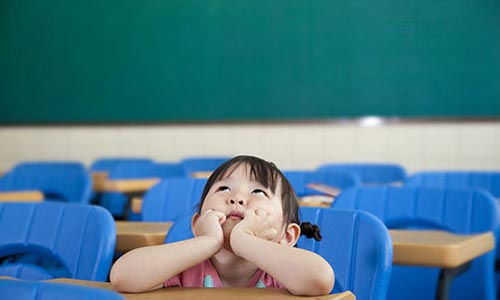Japan’s education system played a central part in Japan’s recovery and rapid economic growth in the decades following the end of World War II. After World War II, the fundamental law of education and the school education law were enacted in 1947 under the direction of the occupation forces. The latter law defined the school system that is still in effect today: kindergarten, ages 3-6 (3 years) elementary school, ages 6 -12 (6 years) junior high school, ages 12-15 (3 years), high school, ages 15-18 (3 years), university and college orderly four and two years. In addition, schools for special needs education, vocational school, specialized higher education and colleges of technology are incorporated.
Education is compulsory at elementary and lower secondary levels in Japan. Most students attend public schools through the lower secondary level, but private education is popular at the upper secondary and university levels. Jan pan has ZERO illiteracy!
Japan has 23,633 elementary schools, 11,134 junior high schools, 5,450 senior high schools, 995 schools for the handicapped, 702 universities, 525 junior colleges, and 14,174 kindergartens (May 2003 figures). School attendance rate for the nine years of compulsory education is 99.98%.
Public schools are funded by a combination of support from the national, municipal and prefectural governments. Public upper secondary school did require tuition, but in March 2010, the government passed a measure intended to abolish these fees. Now, schools receive enrollment support funds that they apply to the cost of their students’ tuition which equals about $100 a month, per student. However, if these funds are not sufficient, the students must make up the difference. If students come from a low-income household, the government provides further subsidies of up to $200 a month.
Private schools also receive a great deal of public funding, with the Japanese government paying 50% of private school teachers’ salaries. Other forms of funding are capital grants, which go to private schools for specific costs, including new buildings and equipment. While private schools are considered to be more competitive and prestigious than public schools, public schools still account for 99% of primary schools and 94% of lower secondary schools. There are many more private upper secondary schools, however; 23% of upper secondary schools are classified as private.
The Japanese government spends less on its schools than do many other OECD countries. Schools are functional but unadorned, and most schools have a very small administrative staff, with only a principal, an assistant principal, a janitor and a nurse. The focus of the funding is on teachers and students. In 2011, Japan spent 5.1% of its GDP on education – lower than the OECD average of 6.1%. Japan spends $8,280 per student in primary school, $9,677 in lower secondary, and $10,093 in upper secondary, compared to the OECD averages of $8,296, $9,377, and $9,506, respectively.
The average salary of teachers is 7500$ but they are responsible to play role not only a teacher but also a researcher. They also required renewing their education personnel certificates every 10 years, after undergoing professional development to ensure that their skills and knowledge are up to date. This new system ensures ongoing professional development, and also provides schools with the ability to remove teachers who are not willing to upgrade or renew their certifications.
In fact, one of the main determinants of educational quality is the competence of the teacher. The high quality of Japanese education owes much to highly qualified teachers. Teaching jobs attract many college graduates because teachers have higher occupational prestige, higher salaries, and generous pensions. Furthermore, teaching is one of the few occupations where people can apply what they have learned in college. Moreover, teaching is one of few professions in which women can build lifelong careers, and simultaneously keep their family commitments. This is why teaching jobs are very competitive, and only one out of every five to eight applicants will eventually become a teacher. The majority of teachers work for almost forty years, until they retire at the age of 60.
Almost all teachers report that they are always busy, and spend much of their time on paperwork and extracurricular clubs. Smaller class sizes for English, mathematics, and science, more team-teaching, and additional teachers have been proposed by the Ministry of Education (MOE) in order to ease the workload of teachers. If schools take on classroom aides and volunteer teachers, teachers would be more effective in the classroom and after school, without massive increases to the educational budget.
The Japan Teachers’ Union (JTU) is composed mostly of leftist unionists who have fought the conservative MOE for control of the educational system since 1947. There is no question that the JTU has promoted peace education, student-centered education, teacher autonomy, higher salaries, and education for minorities, the poor, and low-achievers. However, after losing its political power, the JTU needed to adopt a more moderate strategy. JTU members who opposed the compromise with the MOE left the JTU, and formed the All Japan Teachers and Staffs Union (Zenkyō). The JTU finally compromised with the MOE. Even after adopting more conciliatory approaches to the MOE, the JTU is still struggling to attract young teachers.
Both American and Japanese teachers are growing older, with the average teacher now over 40 years old. Japanese teachers have larger classes without classroom aides than do American teachers; however, they will have smaller classes soon. Unlike American teachers, Japanese teachers spend much more time dealing with paper work, counseling, and student activities. Despite demanding work, the majority of both American and Japanese teachers entered the profession because of a love for children.
Home » Opinion » Distinctive Features of the Japanese Education System
Distinctive Features of the Japanese Education System
| Mohammad Zahir Akbari

